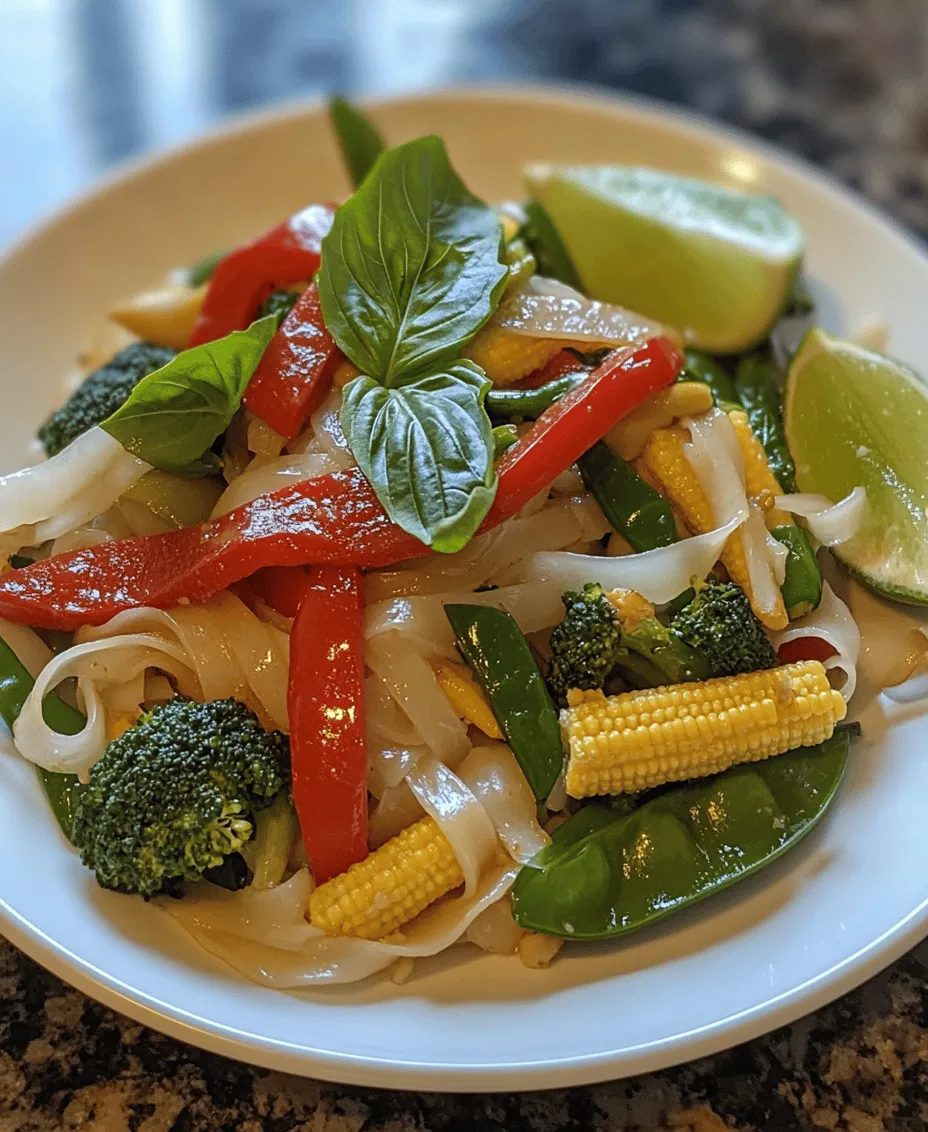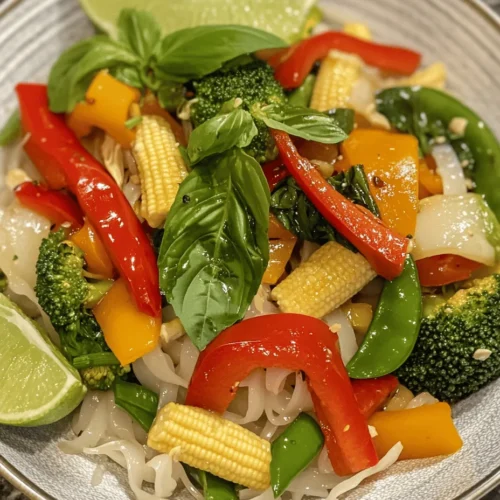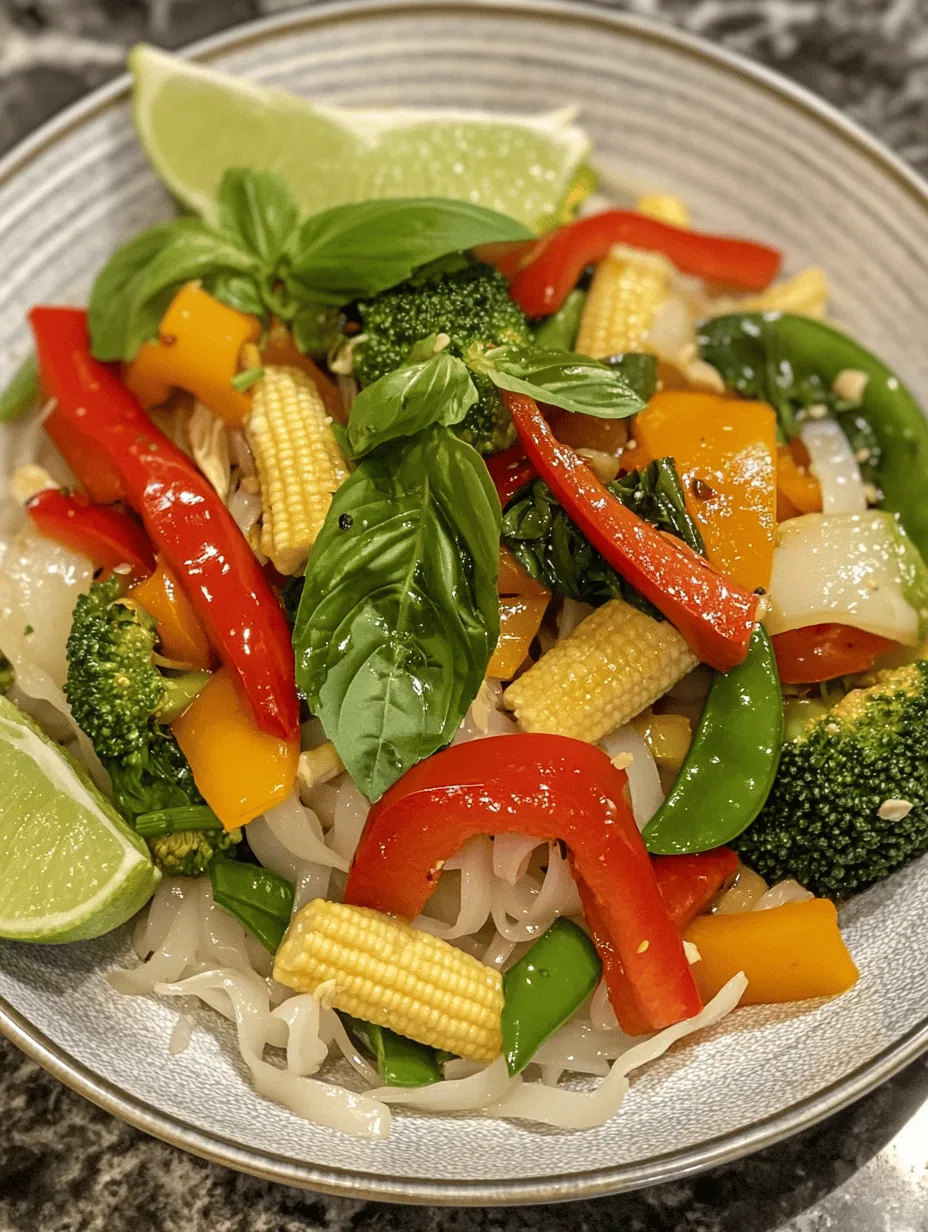Introduction
Drunken Noodles, or “Pad Kee Mao,” is one of the most beloved dishes within Thai cuisine, celebrated not only for its bold flavors but also for its delightful textures. This aromatic stir-fried noodle dish combines flat rice noodles with a colorful array of vegetables, aromatic herbs, and proteins, all brought together by a savory sauce that tantalizes the taste buds. The unique medley of spices and ingredients in Drunken Noodles creates an unforgettable culinary experience that transports diners straight to the bustling streets of Thailand.
The purpose of this article is to provide a detailed recipe for crafting your own Drunken Noodles delight at home while exploring the cultural significance and rich history of this iconic dish. From understanding the origins of its name to mastering the cooking techniques that elevate the dish, we will guide you step-by-step in creating a flavorful masterpiece that will impress your family, friends, and even your own palate.
The Essence of Drunken Noodles
Origins in Thai Cuisine
The origins of Drunken Noodles can be traced back to the vibrant street food culture of Thailand. Though its precise beginnings are somewhat murky, it is widely believed that the dish emerged from the late-night food scene, often enjoyed by those who had indulged in a few too many drinks. The name “Pad Kee Mao” translates roughly to “stir-fried drunk,” reflecting its reputation as a go-to dish for late-night revelers looking for a hearty meal to soak up the festivities.
Drunken Noodles are characterized by their use of wide rice noodles, which are stir-fried with a combination of fresh vegetables, meat or tofu, and a variety of sauces that work together to create a mouthwatering flavor profile. The dish’s popularity has since transcended borders, making it a staple in Thai restaurants around the world. Food lovers are drawn to its unique combination of heat, sweetness, and savory flavors, which come together to create a dish that is as satisfying as it is delicious.
Cultural Context
The cultural significance of Drunken Noodles extends beyond just being a late-night indulgence. In Thailand, food plays an essential role in social gatherings and celebrations, and Drunken Noodles often feature in communal dining experiences. The dish embodies the essence of Thai cuisine—balancing contrasting flavors and textures while showcasing the use of fresh, local ingredients. This balance reflects the philosophy of Thai cooking, which harmonizes sweet, spicy, sour, and salty elements to create a cohesive dish.
Furthermore, Drunken Noodles have become emblematic of the broader Thai culinary scene, representing the country’s rich culinary heritage and its ability to adapt and evolve. As it gains popularity worldwide, it serves as a bridge between cultures, allowing diners to experience the vibrancy of Thai street food wherever they are.
Ingredients Breakdown
To create an authentic and delicious Drunken Noodles dish, you’ll need a variety of fresh ingredients. Here’s a comprehensive list of what you’ll need, along with the role each ingredient plays in achieving the dish’s signature flavors and textures:
Essential Ingredients
1. Flat Rice Noodles: The foundation of Drunken Noodles, these wide noodles are essential for capturing the sauce and providing a chewy texture that is key to the dish’s overall appeal.
2. Protein (Chicken, Shrimp, or Tofu): The choice of protein adds substance to the dish. Chicken and shrimp are common, but for a vegetarian version, tofu serves as a great alternative.
3. Vegetables: Typical vegetables include bell peppers, carrots, and broccoli. These add color, crunch, and nutritional value to the dish.
4. Garlic: Minced garlic provides a fragrant base for the stir-fry and enhances the overall flavor profile.
5. Thai Basil: This aromatic herb is essential for authentic Drunken Noodles. Its slightly spicy flavor and unique aroma elevate the dish to new heights.
6. Soy Sauce: The backbone of the sauce, soy sauce adds a savory umami flavor that is critical for balance.
7. Oyster Sauce: This adds depth and richness to the sauce, complementing other flavors beautifully.
8. Chili Sauce or Fresh Chilies: For those who enjoy heat, adding chili sauce or fresh chilies can elevate the dish’s spiciness, making it more exciting.
9. Eggs: Scrambled eggs are a traditional component that helps to enrich the dish and add a delightful texture.
Alternatives and Substitutions
While the ingredients listed above are traditional, there are many ways to customize your Drunken Noodles to suit your taste preferences or dietary restrictions. For example:
– Thai Basil vs. Regular Basil: Thai basil is preferred for its distinctive flavor, but if unavailable, regular sweet basil can be used in a pinch, though the flavor will vary.
– Vegetable Variations: Feel free to incorporate seasonal vegetables or whatever you have on hand. Snow peas, green beans, or bok choy are excellent alternatives.
– Protein Choices: In addition to chicken, shrimp, or tofu, other proteins like beef or pork can be used, or you can omit the protein altogether for a plant-based version.
Preparing the Noodles
Soaking and Cooking Flat Rice Noodles
To prepare flat rice noodles for your Drunken Noodles, the first step is soaking them properly. Here’s how to do it:
1. Soak the Noodles: Place the flat rice noodles in a large bowl of hot water. Let them soak for about 20-30 minutes, or until they are soft but still slightly firm. This texture is crucial; they should not be completely mushy.
2. Drain and Rinse: After soaking, drain the noodles and rinse them under cold water to stop the cooking process. This also helps prevent the noodles from sticking together.
3. Preparing for Stir-Frying: Once drained, it’s essential to keep the noodles separated. Toss them lightly with a bit of oil to prevent sticking. This step is crucial for achieving that perfect stir-fried texture.
Importance of Texture
The texture of the noodles can make or break your Drunken Noodles. Overcooked noodles can turn mushy and lose their delightful chewiness, while undercooked noodles can be too hard and unpalatable. Striking the right balance is key, so pay close attention to the soaking time and ensure you’re working with noodles that have the right degree of firmness.
Common Mistakes to Avoid
When preparing rice noodles for Drunken Noodles, avoid these common pitfalls:
– Soaking for Too Long: If you soak the noodles for too long, they can become overly soft and difficult to handle.
– Not Rinsing: Failing to rinse your noodles can lead to clumping, making it challenging to achieve that ideal stir-fried texture.
– Skipping the Oil: Neglecting to toss your noodles in oil after rinsing can cause them to stick together during cooking.
By following these steps and avoiding common mistakes, you’ll set a solid foundation for creating a delicious Drunken Noodles dish.
Stir-Frying the Vegetables
Step-by-Step Guide to Stir-Frying
Stir-frying is a quick and versatile cooking method that is central to preparing Drunken Noodles. Here’s how to effectively stir-fry the vegetables to maintain their crunch and vibrant colors:
1. Preheat the Pan: Start by heating a large wok or non-stick skillet over medium-high heat. Allow it to get hot before adding any ingredients, which helps in achieving a nice sear.
2. Add Oil: Once the pan is hot, add a couple of tablespoons of oil (vegetable or peanut oil works well). Swirl the oil around to coat the bottom of the pan evenly.
3. Sauté Garlic: Add minced garlic to the pan and sauté for about 30 seconds until fragrant but not browned. Garlic can burn quickly, so keep an eye on it.
4. Add Vegetables: Quickly add your vegetables to the pan. Start with harder vegetables like carrots and bell peppers, as they take longer to cook. Stir-fry for just a few minutes until they begin to soften but still retain their crunch.
5. Season: As the vegetables cook, season them with a splash of soy sauce and a pinch of salt. This will enhance their flavor and help them cook evenly.
Maintaining Crunch and Color
The goal of stir-frying is not just to cook the vegetables but to lock in their vibrant colors and natural crunch. To achieve this, keep the cooking time short and maintain high heat throughout the process. If you find that the vegetables are starting to soften too much, remove them from the pan and set them aside while you prepare the noodles.
Seasonal Variations
One of the beautiful aspects of Drunken Noodles is its adaptability to seasonal ingredients. Feel free to experiment with different vegetables based on what’s available. For instance, in the summer, zucchini and bell peppers are fantastic options, while fall might call for mushrooms and spinach. This not only enhances the dish’s nutritional value but also allows for creative expression in the kitchen.
Cooking the Eggs
Scrambling Eggs within the Stir-Fry
An essential component of Drunken Noodles is the inclusion of scrambled eggs, which contribute richness and texture to the dish. Here’s how to perfectly scramble eggs within your stir-fry:
1. Push Vegetables to the Side: Once your vegetables are cooked to your liking, push them to the side of the pan, creating a space for the eggs.
2. Add Beaten Eggs: Pour in a couple of beaten eggs into the cleared space and allow them to sit for a few seconds before stirring. This will help them set slightly before scrambling.
3. Scramble and Combine: Using a spatula, gently scramble the eggs until they are just cooked through, then mix them into the vegetables. This technique ensures that the eggs are evenly distributed throughout the dish.
Contribution to Richness and Texture
The addition of eggs not only enriches the flavor but also adds a creamy texture that complements the chewy noodles and crisp vegetables. The eggs absorb some of the sauce, enhancing the overall flavor profile while providing a satisfying mouthfeel.
As you embark on your culinary journey to create Drunken Noodles Delight, keep these insights in mind. The careful preparation of ingredients, attention to cooking techniques, and an understanding of the dish’s cultural significance will guide you in crafting a memorable and delicious experience that brings Thai cuisine right to your kitchen.

Tips for Achieving Perfectly Scrambled Eggs in a Stir-Fry Setting
Scrambling eggs in a stir-fry dish like Drunken Noodles can elevate your meal, adding richness and texture. Here are some tips to ensure your eggs turn out perfectly every time:
– Use Fresh Eggs: Fresh eggs not only taste better but also scramble more beautifully. Look for eggs with a vibrant yolk, as this indicates quality.
– Beat Well: Whisk your eggs thoroughly before adding them to the pan. This incorporates air, which helps create fluffy scrambled eggs. Aim for a uniform mixture of yolks and whites.
– Temperature Control: Start with a hot pan but reduce the heat to medium once you add the eggs. Cooking on high heat can lead to rubbery textures, while a gentle cook allows for soft and creamy eggs.
– Add Oil: Use a neutral oil or a bit of butter in the pan to prevent sticking. This also contributes to flavor. Make sure the oil is shimmering but not smoking before adding your eggs.
– Stir Gently: As soon as you pour in the eggs, use a spatula to push them gently across the pan. This helps create soft curds. Avoid constant stirring; allow some time for the eggs to set slightly before moving them again.
– Remove Early: Eggs continue to cook even after being removed from the heat. Take them off the stove when they are just slightly underdone for the perfect texture when they are combined with the noodles.
Creating the Sauce
A well-balanced sauce is the heart of Drunken Noodles, and understanding the components will enhance your dish significantly.
– Soy Sauce: This is the primary seasoning in many Asian dishes, adding a salty umami flavor to the noodles. Opt for low-sodium soy sauce to control the saltiness and adjust according to your taste.
– Oyster Sauce: This rich, savory sauce adds depth and a hint of sweetness to the dish. It’s made from oyster extracts, which contribute to its unique flavor profile. For a vegetarian option, look for mushroom-based oyster sauce.
– Fish Sauce: A staple in Thai cuisine, fish sauce brings a distinct saltiness and an underlying depth of flavor. Use it sparingly, as it can overpower the dish if too much is added. For a vegetarian substitute, consider using soy sauce mixed with a hint of miso.
The balance of these sauces is crucial. Start with equal parts of soy and oyster sauce, and add fish sauce to taste. Remember, adjusting seasoning to personal preference is key; feel free to experiment until you find your perfect blend.
Combining Ingredients
Once your sauce is ready, it’s time to bring everything together. Combining the ingredients effectively ensures each component of the dish is well-coated and flavorful.
– Noodle Preparation: If using dried rice noodles, soak them in hot water until pliable but not fully cooked. Drain and toss them with a bit of oil to prevent sticking. If you’re using fresh noodles, you can skip the soaking step.
– Order of Ingredients: Add the vegetables to the hot wok first, allowing them to stir-fry for a few minutes until they soften slightly. Then, push the vegetables to the side to create space for the eggs. Scramble the eggs in this empty space, then mix in the noodles.
– Sauce Application: When the noodles and vegetables are combined, pour the sauce over them. Use tongs or a spatula to toss everything together, ensuring each noodle is coated evenly. This helps distribute the flavors throughout the dish.
– Timing is Key: Stir-frying is about speed and timing. Make sure to keep the ingredients moving in the pan to avoid burning and to ensure even cooking. The entire process should only take about 5-7 minutes.
Finishing Touches with Thai Basil
Thai basil is a hallmark of this dish, adding a unique flavor and aroma that sets Drunken Noodles apart from other stir-fry recipes.
– Flavor Enhancer: The slightly spicy and sweet notes of Thai basil brighten the dish and complement the savory sauces. It’s essential to add it at the end of cooking to preserve its vibrant flavor.
– Incorporation Techniques: After tossing the noodles and sauce together, add a generous handful of Thai basil right before serving. Gently mix it in, allowing the residual heat to wilt the leaves without losing their freshness.
– Aromatic Properties: Thai basil’s aromatic oils are released when heated but can dissipate quickly. By adding it towards the end, you not only maintain its flavor but also enhance the dish’s aroma.
Serving Suggestions
Presentation can elevate your dining experience. Here are some ideas to make your Drunken Noodles visually appealing:
– Plating: Serve the Drunken Noodles in a shallow bowl or a wide plate to showcase the colorful vegetables and noodles. Top with a few fresh basil leaves for an attractive touch.
– Cultural Accompaniments: Lime wedges are a traditional accompaniment for many Thai dishes, including Drunken Noodles. A squeeze of fresh lime juice adds a burst of acidity that balances the richness of the sauce.
– Beverage Pairing: For a complete dining experience, consider pairing your Drunken Noodles with a refreshing Thai iced tea or a light beer. The flavors of these beverages complement the spices and richness of the dish beautifully.
Nutritional Information
Understanding the nutritional profile of Drunken Noodles can help you make informed choices while enjoying this flavorful dish.
– Nutritional Breakdown: A typical serving of Drunken Noodles contains approximately 400-600 calories, depending on the portion size and specific ingredients used. The dish is a good source of carbohydrates from the noodles, protein from the eggs and any added meats, and various vitamins from the vegetables.
– Health Benefits: The vegetables included in Drunken Noodles, such as bell peppers, carrots, and broccoli, provide essential vitamins and minerals. Additionally, the use of fresh herbs like Thai basil adds antioxidants and anti-inflammatory properties.
– Dietary Considerations: For those seeking vegan options, simply omit the eggs and any meat, and consider using tofu as a protein source. To make the dish gluten-free, substitute regular soy sauce with tamari or a gluten-free soy sauce alternative.
Conclusion
Making Drunken Noodles Delight is an enriching culinary journey that brings together vibrant flavors, textures, and cultural traditions. From the careful preparation of ingredients to the delicate balance of sauces, each step is crucial in crafting this beloved Thai dish.
Encouraging readers to explore their kitchens and try their hand at Thai cuisine not only opens up a world of flavors but also fosters a deeper appreciation for diverse culinary traditions. The process of cooking can be both creative and rewarding, and Drunken Noodles is a perfect dish to start or continue that journey. Enjoy the experience, share it with friends and family, and let the delightful flavors of this dish transport you to the bustling streets of Thailand.



